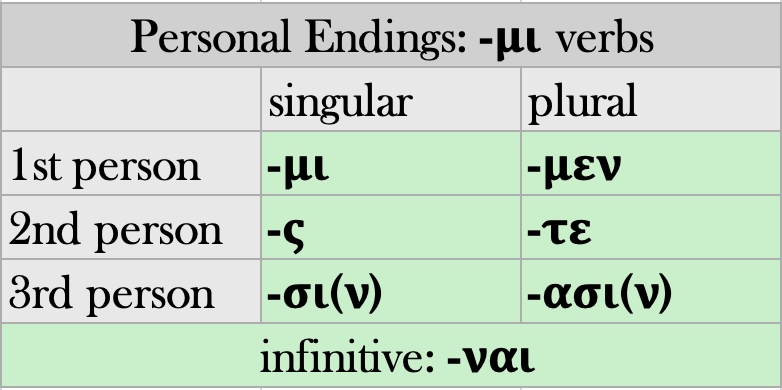5.1 Two Greek verbs, εἰμί and φημί, are inflected much like δείκνυμι. Following the general Greek principle of spelling words as they sound, each shows spelling changes that reflect changes in pronunciation over time. These verbs are common, and important to master.
5.2 The most common verb in Greek is εἰμί, to be. Like most Indo-European languages, the verb to be tends to exhibit irregular forms. Consider the present indicative of to be in English: I am; You are; (S)he/it is…
The Present Indicative Active of εἰμί likewise exhibits irregularities of form and accent that require memorization (S 768, G 384).
- Read more
-
As you memorize the inflection of this verb, it may be helpful to understand the sound changes reflected in these forms. Recall that a Greek verb builds out from its VERB STEM, which designates the action that the verb describes. The verb stem for εἰμί is:ἐσ- = “be”
Recall also the personal endings that indicate person and number of the present, indicative, active:
At first glance, then, this verb appears to be behaving badly; only ἐσμέν and ἐστέ are regular. One of the problems, no surprise, is the sigma. Since the verb εἰμί has a stem ending in –σ, contractions and irregularities in pronunciation – and therefore spelling – occur over time once the personal endings are added.
Consider, for example, the following changes:• ἐσμί → εἰμί (1st person, singular)
• ἔσναι → εἶναι (present infinitive)
Note the pattern: each of these forms begins with εἰ-, and the –σ– has been lost. This process – in which a short vowel is lengthened (here, ε becoming ει) to “make up” for the loss of a consonant during pronunciation – is called COMPENSATORY LENGTHENING (S 37). Often, the consonant loss that led to compensatory lengthening was –σ– (S 105).
The most unusual forms of εἰμί are εἶ, ἐστί and εἰσί. The form εἶ comes from ἔσ–σι, which reflects an old form of the 2nd Person Singular, –σι. Over time, the σ‘s dropped out, producing έὲ → εἶ (S 770). The form ἐστί is actually regular (!); it just uses the prehistoric 3rd Person Present Indicative Active ending, –τι (S 463c). In fact, εἰμί is the only verb in Classical Greek to retain this prehistoric personal ending unchanged, providing a good example of a linguistic “fossil” retained due to its frequent use over time. (In fact, most “irregular” forms in a language are better understood as linguistic fossils). Similarly, the personal ending –ντι is the original 3rd Person Plural Present Indicative Active ending; εἰσί is the result of gradual changes in the pronunciation of the putative verb form ἐσντί (S 463). In other words, the irregularities found in εἶ, ἐστί and εἰσί reflect survivals from an earlier period of spoken Greek!


